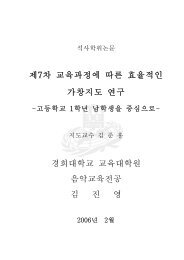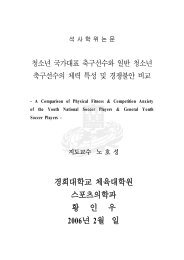경희대학교 동서의학대학원 의 학 영 양 학 과 김 선 아
경희대학교 동서의학대학원 의 학 영 양 학 과 김 선 아
경희대학교 동서의학대학원 의 학 영 양 학 과 김 선 아
Create successful ePaper yourself
Turn your PDF publications into a flip-book with our unique Google optimized e-Paper software.
Ⅰ. Collagen<br />
Collagen is the most abundant protein (by weight) in animals, accounting<br />
for 30% of all proteins in mammals. Collagen assembles into different<br />
supramolecular structures and has exceptional functional diversity. Collagen<br />
is the major protein of connective tissue, tendons, ligaments, and the<br />
cornea, and it forms the matrix of bones and teeth.<br />
Collagen is a protein with three polypeptide chains. Each chain has 1000<br />
amino acids and contains at least one stretch of the repeating amino acid<br />
sequence Gly-X-Y (where X and Y can be any amino acid but are usually<br />
proline and hydroxyproline, respectively.(van der Rest M, Garrone R. 1991)<br />
Ⅰ-1. Collagen and skin<br />
The skin is the largest organ of the body. It is made up of three distinct<br />
layers: the Epidermis, the dermis and the subcutaneous tissue. Each has its<br />
own unique function, yet are interrelated.<br />
The epidermis, the outer layer, acts as a protective shield. It is comprised<br />
of multiple cell strata that serve to regenerate the skin’s protective function.<br />
The epidermis continuously sloughs keratinated cells of its outer layer, the<br />
stratum corneum, every thirty days or so. This regeneration occurs naturally<br />
through wear and tear such as bathing, friction from clothing and exposure<br />
to the environment.<br />
The middle layer is the dermis, through which blood vessels and nerve<br />
receptors penetrate to the epidermis. In this layer, chemical and enzymatic<br />
- 2 -

















